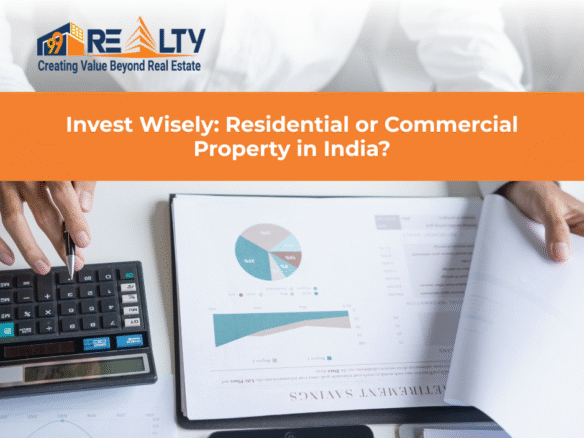Real estate is often pitched as the golden goose of wealth building. But once you decide to invest, the next big question pops up — How?
Should you climb the property ladder, selling and upgrading with each move? Or go with the classic buy-and-hold, sitting back and letting rent and appreciation do the work?
Let’s break down both strategies, compare their pros and cons, run some real numbers, and figure out which one could potentially offer higher returns.
Explore the Benefits of Green Building Certifications in Real Estate
What Is Property Laddering?
Property laddering is like playing Monopoly but in real life. You start with a small investment property, hold it for a few years as its value appreciates, sell it, and use the profits to buy a better property. Repeat the process. You’re basically “laddering” up in value.
Step-by-Step Breakdown of Laddering
- Buy a small flat or affordable property.
- Wait for appreciation (usually 3–5 years).
- Sell and use the profit (plus fresh capital if needed) to buy a bigger property.
- Repeat the process every few years.
- After 2–3 upgrades, you’re sitting on a high-value asset.
Real-Life Example of Laddering in India
Imagine you buy a ₹25 lakh flat in a Tier-3 city. It appreciates by 8% annually. In 5 years, it’s worth around ₹36.7 lakhs. You sell it, add ₹10 lakhs more and buy a ₹46 lakh apartment in a better area. That appreciates faster, say at 10%. After 5 more years? It’s ₹74.3 lakhs. Repeat again, and you’re looking at a ₹1.2 crore property in 15 years. Not bad, right?
Benefits of Living in a Gated Society vs Standalone Apartment Building
Calculating Gains Through Step-Ups
- Property 1 (₹25L ➝ ₹36.7L)
- Property 2 (₹46L ➝ ₹74.3L)
- Property 3 (₹75L ➝ ₹1.2 Cr+)
You don’t just grow your assets — you upgrade neighborhoods, rental yields, and tenant quality too.
What Is Buy-And-Hold?
This is the “slow and steady wins the race” strategy. Buy a good property and hold onto it. Let it appreciate while earning rental income monthly. It’s simple, passive, and predictable.
Long-Term Rental Income Explained
The idea is to:
- Buy once
- Rent out forever
- Reap monthly income
- Wait for long-term appreciation
Think of it like planting a mango tree. It takes time to grow, but then it fruits every season without fail.
Case Study: Buy-and-Hold in Tier-2 Cities
Let’s say you buy a ₹50 lakh flat in Lucknow. You rent it for ₹15,000/month, increasing rent by 5% every year. Over 10 years, you could earn over ₹23.5 lakhs in rent — that’s almost half your purchase price back.
Plus, if the property appreciates to ₹85 lakhs in 10 years, you’ve got ₹35 lakh in capital gain. Not too shabby!
Appreciation vs. Rental ROI
While laddering focuses mostly on appreciation, buy-and-hold delivers a dual benefit:
- Monthly rent (cash flow)
- Long-term appreciation (capital growth)
Comparing the Two Strategies
Capital Growth
Laddering wins here — it compounds capital faster by trading up assets. You ride rising markets and always shift to better locations or larger properties.
Cash Flow Consistency
Buy-and-hold dominates. If your goal is passive income, this is your game. Laddering doesn’t generate regular income since you’re constantly flipping.
Risk and Flexibility
- Laddering is riskier — if property prices stagnate, your ladder breaks.
- Buy-and-hold is stable — even in slow markets, rent keeps coming in.
Tax Benefits and Legal Considerations
Tax Breaks for Buy-and-Hold Investors
- Section 24(b): Deduct interest on home loan up to ₹2L.
- Section 80C: Principal repayment deduction.
- Depreciation claims if held under a company or as part of a rental business.
Capital Gains Implications for Laddering
Frequent selling means more short-term or long-term capital gains tax.
- LTCG (after 2 years): 20% with indexation.
- STCG (before 2 years): As per slab.
Planning your sales smartly is crucial.
How to Decide Which One Fits You?
Personality and Risk Appetite
- Risk taker? Ambitious? Like upgrading your life every 3–5 years? Laddering is your style.
- Prefer safety? Love monthly income? Not a fan of buying/selling stress? Go buy-and-hold.
Location & Market Timing
- Laddering works best in emerging markets or metros with rapid appreciation.
- Buy-and-hold shines in stable rental markets like Pune, Kochi, or Indore.
Hybrid Approach: The Best of Both Worlds?
Why not start with laddering in your 30s to build capital, then switch to buy-and-hold in your 40s for passive income?
You could also:
- Flip one property every 5 years
- Hold one long-term for rental
- Diversify locations to manage risk
Mistakes to Avoid
- Over-leveraging in laddering: EMIs can crush you if prices drop.
- Buying poor rental yield properties in buy-and-hold: Aim for 3–4% yield minimum.
- Ignoring property taxes, maintenance, and vacancy risks.
- Forgetting that market cycles exist. You may buy high and sell low if emotional.
Final Verdict: Which One Wins?
There’s no one-size-fits-all.
- For fast capital growth: Property laddering is the rocket ship.
- For predictable wealth and income: Buy-and-hold is your steady train.
Think about your goals. Need cash flow? Or want long-term asset growth? Play the game that fits your life.
Conclusion
At the end of the day, both property laddering and buy-and-hold can make you rich — but in very different ways. It’s like comparing a sprinter and a marathoner. Each shines in their own lane.
Want explosive growth? Start climbing that ladder. Want peace of mind and rental cheques? Hold tight and let time do its magic.
Just make sure to educate yourself, understand your risk profile, and play smart. Real estate is powerful — if you play it right.
FAQs
1. Is laddering suitable for first-time investors?
Yes, but only if you’re ready to commit long-term and manage multiple buy-sell transactions strategically.
2. Can I combine both strategies?
Absolutely. Many successful investors use laddering early to build capital and switch to buy-and-hold for retirement.
3. What are the risks of buy-and-hold?
Tenant issues, maintenance costs, low appreciation in some areas, and long holding periods can hurt returns.
4. What cities are ideal for laddering in India?
Look for rapidly developing urban belts like parts of Navi Mumbai, Noida Extension, or peripheral Hyderabad.
5. How do I know when to sell in laddering?
Watch for signs of peak market prices, slowing growth, or better opportunities elsewhere. A good rule is to reevaluate every 4–5 years.
Disclaimer
Information provided by 99 Realty is for general guidance only and does not constitute legal, financial, or investment advice. Market conditions, prices, and regulations may change without notice. Users are advised to verify details independently and consult professionals before making real estate decisions. 99 Realty is not liable for any losses arising from reliance on this information.
Need Help?
Need help evaluating a property or planning your next move in the market?
Reach out to 99 REALTY – your trusted real estate partner for smarter choices.
Subscribe to get updates on our latest posts and market trends.






Join The Discussion